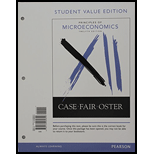
Calculate the values of exports, imports, and
Explanation of Solution
Table-1 shows the values of exports, imports, and balance of trade of the top five trading partners of the U S in 2014 below:
Table-1
|
Country | Exports(in dollar) | Imports ( in dollar) | BOT (in dollar) |
|
Can | 374,864 | 384,428 | −9,564 |
|
Chi | 167,207 | 482,323 | −315,116 |
|
Mex | 270,721 | 320,889 | −50,168 |
|
Jap | 114,712 | 167,916 | −53,205 |
|
Germ | 77.823 | 156,986 | −79,163 |
The value of the exports and imports of different products will vary.
In the case of Can, they export and import the same products with the US, such as fuel, vehicle, and machinery.
Chi imports mainly agricultural items from the US and exports of furniture, toys, machinery, clothes to the US.
Mex exports and imports the same products with the US, such as fuel, vehicle, and machinery.
Jap exports and imports the same products with the US, such as medical instruments, aircraft, and machinery.
Germ exports machinery, vehicle, and pharmaceutical products to the US and imports aircraft, machinery, medical instruments, and pharmaceutical products from the US.
Exports: Exporting is the process of sending goods and services from one country to another country as part of the trade transaction.
Imports: Importing is the process of implementing goods and services from one country to another country as part of the trade transaction.
Balance of trade: The balance of trade shows the difference between the exports and imports in a country.
Want to see more full solutions like this?
Chapter 20 Solutions
Principles of Microeconomics, Student Value Edition Plus MyLab Economics with Pearson eText -- Access Card Package (12th Edition)
- In recent decades, has the U.S. trade balance usually been in deficit, surplus, or balanced?arrow_forwardSome economists warn that the persistent trade deficits and a negative current account balance that the United States has run will be a problem in the long run. Do you agree or not? Explain your answer.arrow_forwardIf you observed a country with a rapidly growing trade surplus over a period of a year or so,would you be more likely to believe that the country's economy was in a period of recession or of rapid growth? Explain.arrow_forward
- If China has a trade surplus with the United States, it is a good thing for the U.S economy? True or Falsearrow_forwardA popular measure of a country’s “openness” to international trade is an index computed as the sum of the country’s exports and imports divided by its GDP. Calculate and graph the openness index for the United States using quarterly data since 1947. What has been the postwar trend? Can you think of any factors that might help explain this trend? (Hint: Be careful with the data, as some databases record imports with a negative sign and then add them to exports to get net exports. If that is the case with your data, take the absolute value of imports before adding it to exports, because we are interested in the total volume of trade, not the balance of trade.)arrow_forwardSuppose Country X experienced a decline in the trade of manufactured goods. To account for this, Country X had to become a borrower of foreign funds. For the next 10 years, Country X used the borrowed funds to improve the nation's treatment plants and to develop efficient better transit system. This created jobs in its workforce. The country began to repay its debt that it had borrowed. Which of the following contributed most to this country's successful economic recovery? the creation of a trade deficit through more aggressive buying of imports ensuring that larger borrowing reduced the need for more private savings O global policies of low interest rates charged on funds borrowed by governments O ensuring borrowed funds were invested in long-term productive economic assetsarrow_forward
- Suppose the US goes into a recession where the economy is not growing very quickly (or is actually shrinking) while the economies of our trading partners remain strong. What will most likely happen to our trade deficit? In your answer, explain what will happen to US exports and US imports and why.arrow_forwardExchange Rate Effects on Trade Explain why a stronger dollar could enlarge the U.S. balance-of-trade deficit. Explain why a weaker dollar could affect the U.S. balance-of-trade deficit.arrow_forwardSuppose that during a recent year for the United States, merchandise imports were $2 trillion, unilateral transfers were a net outflow of $0.2 trillion, service exports were $0.2 trillion, service imports were $0.1 trillion, and merchandise exports were $1.4 trillion. What was the merchandise trade deficit? What was the balance on goods and services? What was the current account balance?arrow_forward
- What have been the major causes of the large U.S. trade deficits in recent years? What are the major benefits and costs associated with trade deficits? Explain: “A trade deficit means that a nation is receiving more goods and services from abroad than it is sending abroad.” How can that be considered to be “unfavorable”?arrow_forwardThe following graph depicts the supply and demand curves for U.S. dollars in the foreign exchange market. Suppose that Japan puts quotas on all U.S. imports. On the graph, shift either the supply of dollars curve, the demand for dollars curve, or both curves to best reflect the given scenario. PRICE (Yen per dollar) S D QUANTITY OF DOLLARS (Millions per day) If Japan puts quotas on all U.S. Imports, the U.S. dollar 6.4.arrow_forwardIf the United States imports more than it exports, it will have a: trade surplus, trade deficit, import balance, trade balancearrow_forward
 Exploring EconomicsEconomicsISBN:9781544336329Author:Robert L. SextonPublisher:SAGE Publications, Inc
Exploring EconomicsEconomicsISBN:9781544336329Author:Robert L. SextonPublisher:SAGE Publications, Inc
 Principles of Economics 2eEconomicsISBN:9781947172364Author:Steven A. Greenlaw; David ShapiroPublisher:OpenStax
Principles of Economics 2eEconomicsISBN:9781947172364Author:Steven A. Greenlaw; David ShapiroPublisher:OpenStax Macroeconomics: Principles and Policy (MindTap Co...EconomicsISBN:9781305280601Author:William J. Baumol, Alan S. BlinderPublisher:Cengage Learning
Macroeconomics: Principles and Policy (MindTap Co...EconomicsISBN:9781305280601Author:William J. Baumol, Alan S. BlinderPublisher:Cengage Learning



